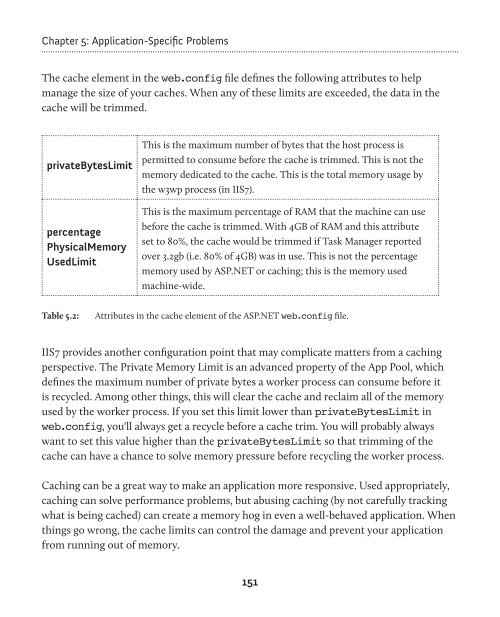Under the Hood of .NET Memory Management - Simple Talk
Under the Hood of .NET Memory Management - Simple Talk
Under the Hood of .NET Memory Management - Simple Talk
You also want an ePaper? Increase the reach of your titles
YUMPU automatically turns print PDFs into web optimized ePapers that Google loves.
Chapter 5: Application-Specific Problems<br />
The cache element in <strong>the</strong> web.config file defines <strong>the</strong> following attributes to help<br />
manage <strong>the</strong> size <strong>of</strong> your caches. When any <strong>of</strong> <strong>the</strong>se limits are exceeded, <strong>the</strong> data in <strong>the</strong><br />
cache will be trimmed.<br />
privateBytesLimit<br />
percentage<br />
Physical<strong>Memory</strong><br />
UsedLimit<br />
This is <strong>the</strong> maximum number <strong>of</strong> bytes that <strong>the</strong> host process is<br />
permitted to consume before <strong>the</strong> cache is trimmed. This is not <strong>the</strong><br />
memory dedicated to <strong>the</strong> cache. This is <strong>the</strong> total memory usage by<br />
<strong>the</strong> w3wp process (in IIS7).<br />
This is <strong>the</strong> maximum percentage <strong>of</strong> RAM that <strong>the</strong> machine can use<br />
before <strong>the</strong> cache is trimmed. With 4GB <strong>of</strong> RAM and this attribute<br />
set to 80%, <strong>the</strong> cache would be trimmed if Task Manager reported<br />
over 3.2gb (i.e. 80% <strong>of</strong> 4GB) was in use. This is not <strong>the</strong> percentage<br />
memory used by ASP.<strong>NET</strong> or caching; this is <strong>the</strong> memory used<br />
machine-wide.<br />
Table 5.2: Attributes in <strong>the</strong> cache element <strong>of</strong> <strong>the</strong> ASP.<strong>NET</strong> web.config file.<br />
IIS7 provides ano<strong>the</strong>r configuration point that may complicate matters from a caching<br />
perspective. The Private <strong>Memory</strong> Limit is an advanced property <strong>of</strong> <strong>the</strong> App Pool, which<br />
defines <strong>the</strong> maximum number <strong>of</strong> private bytes a worker process can consume before it<br />
is recycled. Among o<strong>the</strong>r things, this will clear <strong>the</strong> cache and reclaim all <strong>of</strong> <strong>the</strong> memory<br />
used by <strong>the</strong> worker process. If you set this limit lower than privateBytesLimit in<br />
web.config, you'll always get a recycle before a cache trim. You will probably always<br />
want to set this value higher than <strong>the</strong> privateBytesLimit so that trimming <strong>of</strong> <strong>the</strong><br />
cache can have a chance to solve memory pressure before recycling <strong>the</strong> worker process.<br />
Caching can be a great way to make an application more responsive. Used appropriately,<br />
caching can solve performance problems, but abusing caching (by not carefully tracking<br />
what is being cached) can create a memory hog in even a well-behaved application. When<br />
things go wrong, <strong>the</strong> cache limits can control <strong>the</strong> damage and prevent your application<br />
from running out <strong>of</strong> memory.<br />
151











